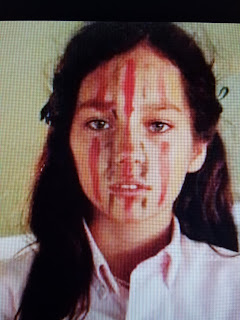I find it anachronistic how black and white photography continues to dominate the artsier end of the market even to this day. Perhaps it generally is more aesthetically pleasing. Or perhaps it's the Keep Calm and Carry On brigade with their nostalgia for a time that never was. Either way it's remarkable, and a little disappointing, how monochrome continues to dominate over colour.
Before 1978 colour photography was actively looked down on. There were a few notable exceptions but the man who did the most to change that perception was Memphis, Tennessee's William Eggleston and his show, that year, at New York's Museum of Modern Art.
His subjects came from around the world but often from Memphis itself and the nearby Mississippi delta. Some are strangers but many were friends and family. Some of the 100 photos at the NPG's current show are from his personal archive and haven't been shown in public before. Another scoop is that this exhibition also reveals the identity of some of the sitters (if they could be called that, Eggleston worked quick). The artist had been reluctant, in the past, to name names.
Straight away we can see his non-posed 'snapshot' approach. His mother and Lucille Fleming, their housekeeper (below), appear in an early 60s set when he still worked in black and white.
Friends featured too. Eggleston moved with hippies, blues musicians, and gay activists. He used to hang out at Trader Dick's in Memphis with the band Big Star. The bar had a reputation for fights and Quaalude abuse. Eggleston drew a picture for Alex Chilton in which you can clearly see the influence he took from Kandinsky, the Blaue Reiter Group, and American Abstract Expressionism.
He'd also hang at TGI Friday's with the less well remembered bluegrass band Crawdad. He seemed to like bars. On road trips from Memphis down to New Orleans he'd photograph people he found in them. A friend, Chick Reeder, recalls Eggleston entering churches around the delta and playing Bach on the organ for hours on end.
He wasn't just there for the good times though. He caught the ups and downs of life too as evinced by his 1974 image of his girlfriend Leigh Hazlip crying her eyes out. A much warmer portrait is the one of his daughter, Andra, with her face painted taken a decade later. She looks confident and studious and, somehow, proud of her dad and his work.
Family shots of breast feeding, sleeping toddlers etc; suggest a contented, if still questing, man. This 1969/70 photo of his uncle Aydn Schuyler Senior with his 'house man' Jasper Staples at Cassidy Bayou in Mississippi speaks volumes about the times whilst managing to remain masterfully understated. It's a great snap.
Novelist Eudora Welty and cult turned mainstream actor Dennis Hopper were both friends and subjects of Eggleston. He met Joe Strummer for a beer (the guy in the Clockwork Orange t-shirt is surely not an accident) and played piano on a Big Star album. His interaction with country blues musician Mississippi Fred McDowell, however, was a bit of a one sided affair.
Perhaps Eggleston's oddest friend was the eccentric dentist and casual nudist T.C.Boring whose home was covered in spray painted graffiti. On Mother's Day 1980 Boring's house was set on fire with Boring inside it. He died.
It's this house that's the subject of Eggleston's most famous photo The Red Ceiling. It's not in this show because it's not a portrait but I've included it anyway. Not least because they wouldn't let me take photos (of the photos) in the gallery.
That aside it was an interesting look at one of America's most innovative photographers. Eggleston would complain that he wasn't particularly interested in things but that he liked taking photos. Take photos of the dull things was his friend's response. So he did and the strange thing was that the results were anything but boring.









No comments:
Post a Comment